All-Star Squadron #11
Little continuity error there, with the alien's boots.
Creative Team: Roy Thomas-writer, Adrian Gonzales-pencils, Jerry Ordway-inks, Ben Oda-letters, Carl Gafford-colors, Len Wein-editor
Synopsis: Akhet, from the 2nd planet in the Proxima Centauri system, claims the Earth in the name of the Binary Brotherhood; isn't that lovely? He demands an end to the war and everyone surrender to his planet or get smooshed. The All-Stars tell him to get stuffed and attack (except Liberty Belle, who wants to wait for FDR to make the call). Johnny Quick, Robotman, Steel and Hawkgirl attack...
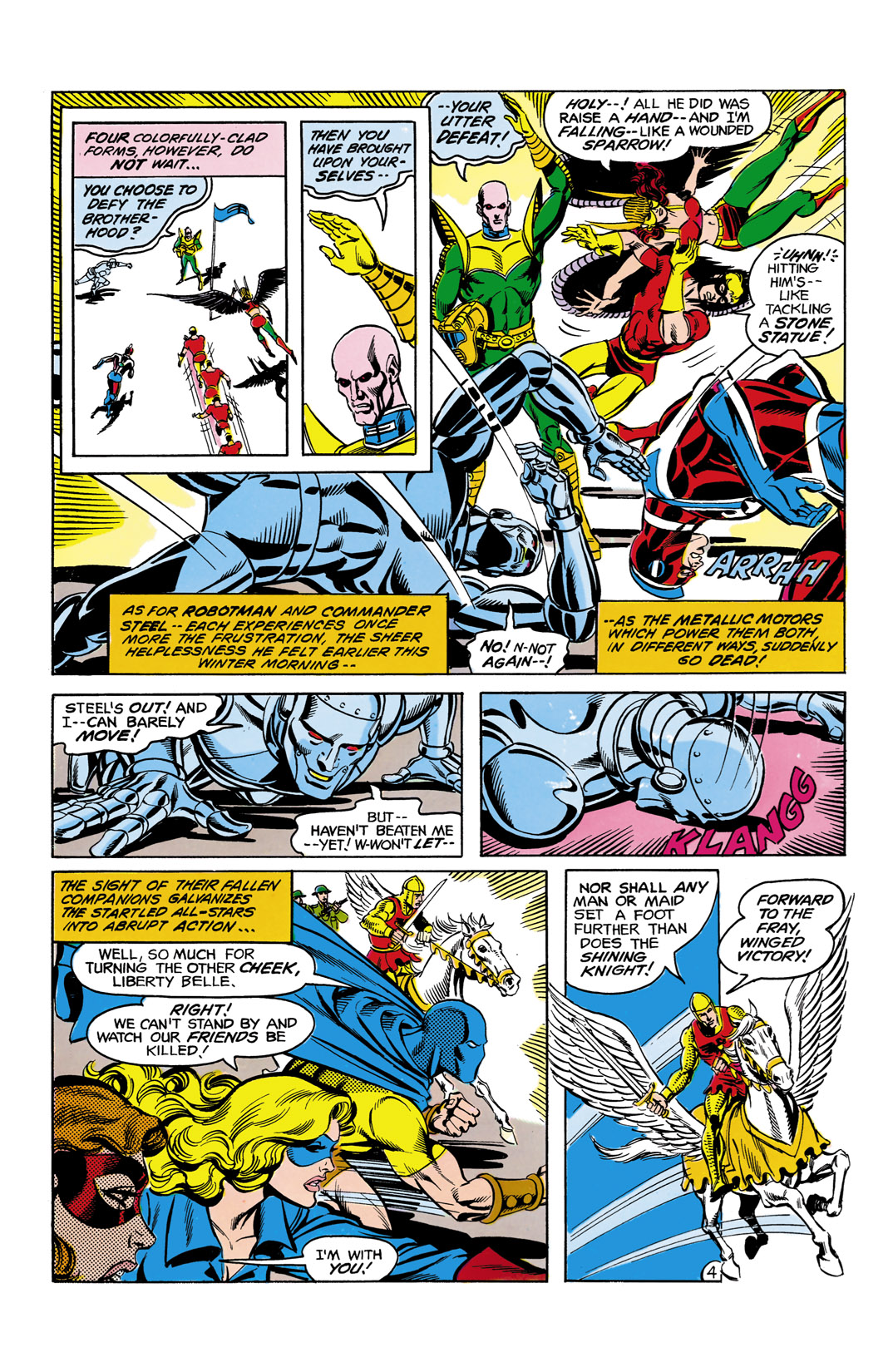
Well, now the rest are committed, so "Have at you!"

Well, that sucked! The alien takes off with Hawkgirl, Robotman, Steel and Atom as hostages, and Firebrand and Sir Justin can't stop him. The Army Air Force can't stop him. The nations of the world cringe in terror at the sight of the flying eye. It appears over the Brandenburg Gate, as we see Hitler berating his staff....
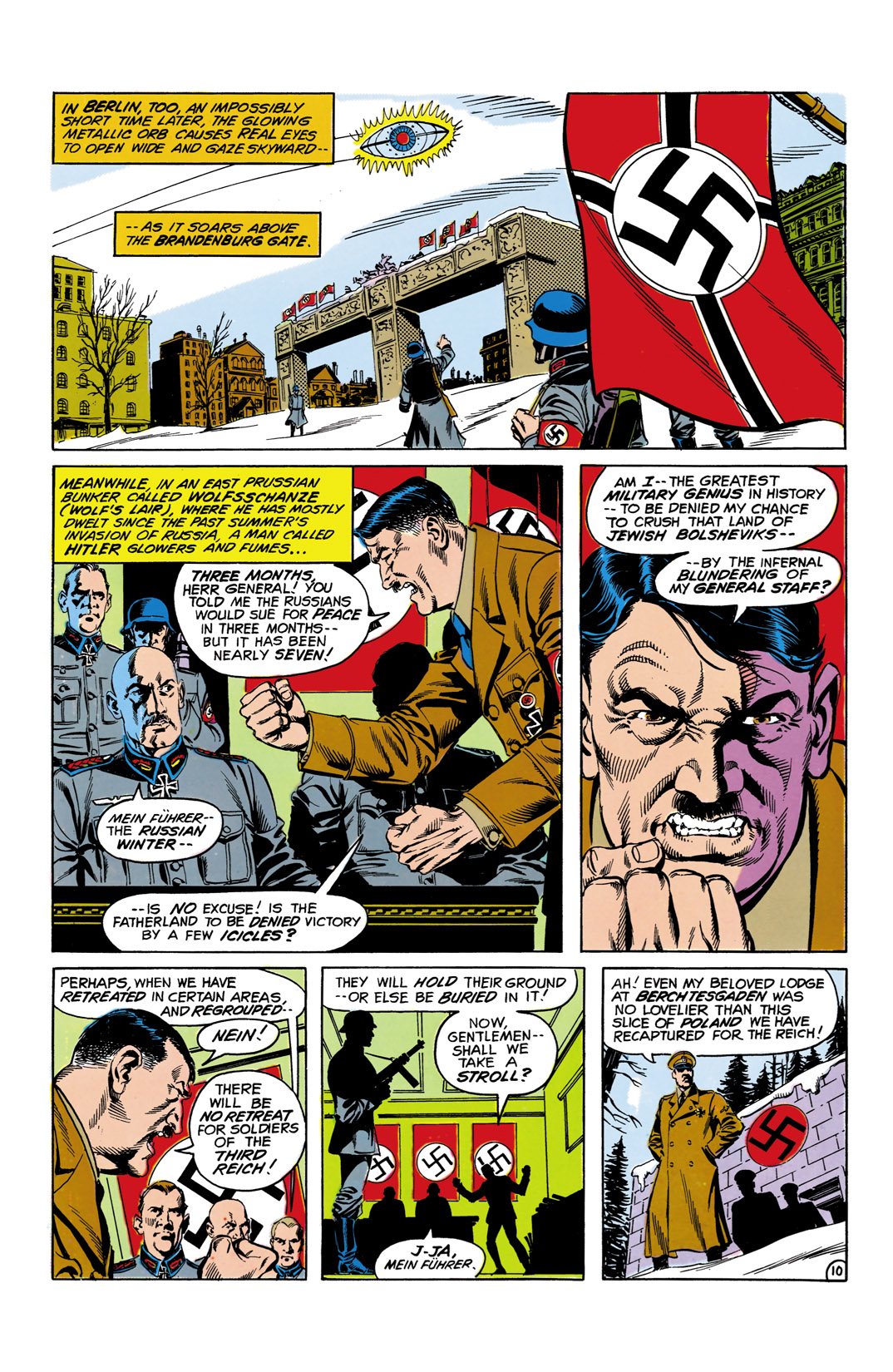
Gee, where have I seen and heard behavior like that....hm...something familiar about that leadership style....
Schicklgruber goes for a stroll and the Eye appears over Wolf's Lair and then smooshes some Nazis and Der Fuhrer's Face has egg all over it. The eye then visits Stalin, Chiang Kai-Shek, Hideki Tojo, and Donald trump's favorite quote-make, Benito Mussolini. The trains run a bit late, that day.
At the White House, gen. George C Marshall outlines everyone's position. Hitler, Mussolini and Tojo agree to team up, provided the current status quo of conquered territory remains. Kai-Shek agrees is Mao does, and Stalin isn't talking. Everyone says "Nuts" to surrendering, but, they recognize they got their hinders handed to them. Liberty Belle says something isn't kosher about the eye, as it didn't just destroy the White House outright and take over. they are interrupted by a report of a UFO and everyone is a bit trigger happy; but, it is Hawkman.
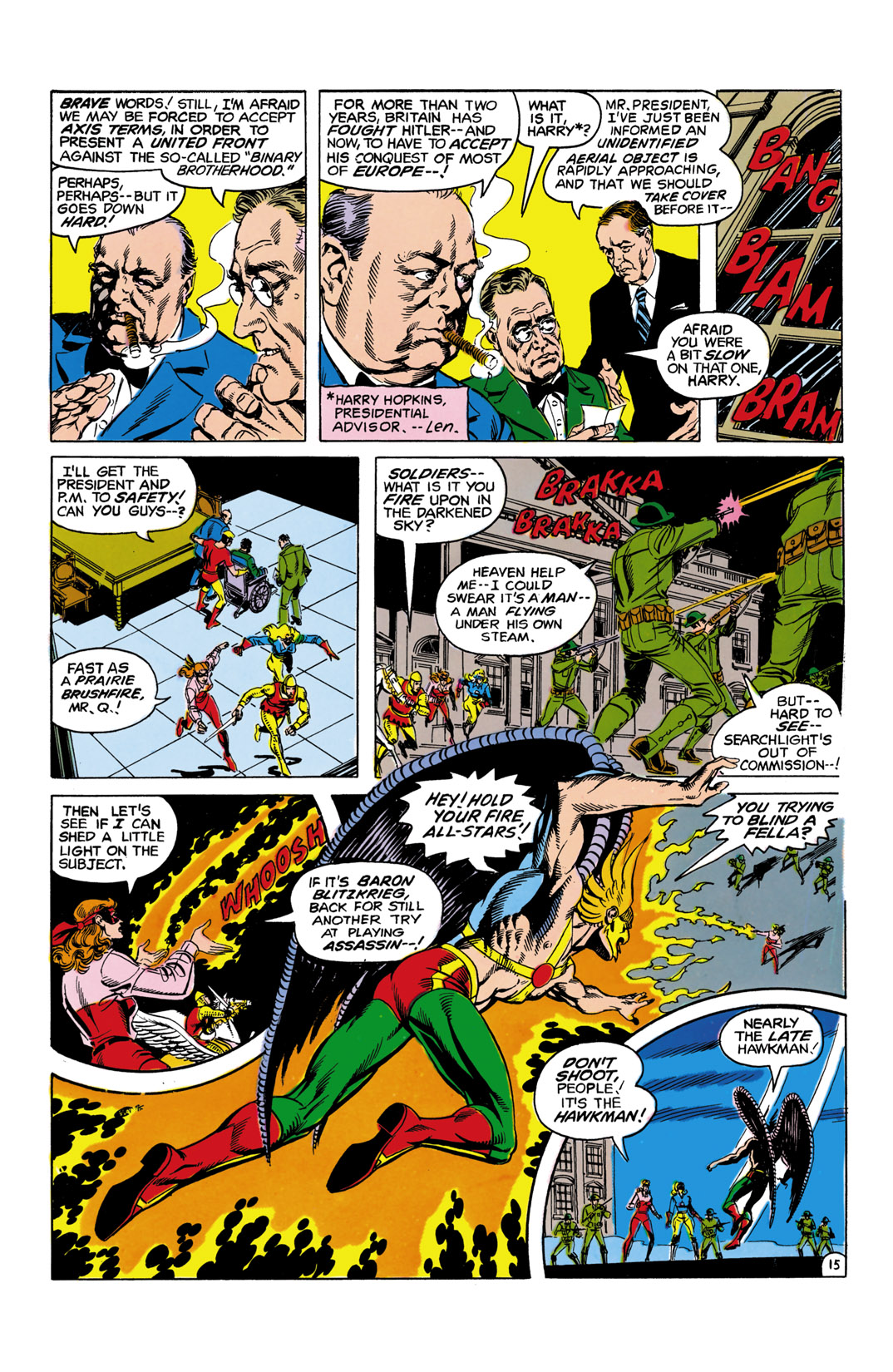
He tells them about the first encounter with the eye. He recognizes the alien symbol as a medieval alchemist symbol for "Spirit of the World." The dead guy that he caught was bio-chemist Garret Owens, who disappeared in 1933.
Meanwhile, Hawkgirl wakes up on the alien ship, which looks curiously like the interior of a large aircraft...
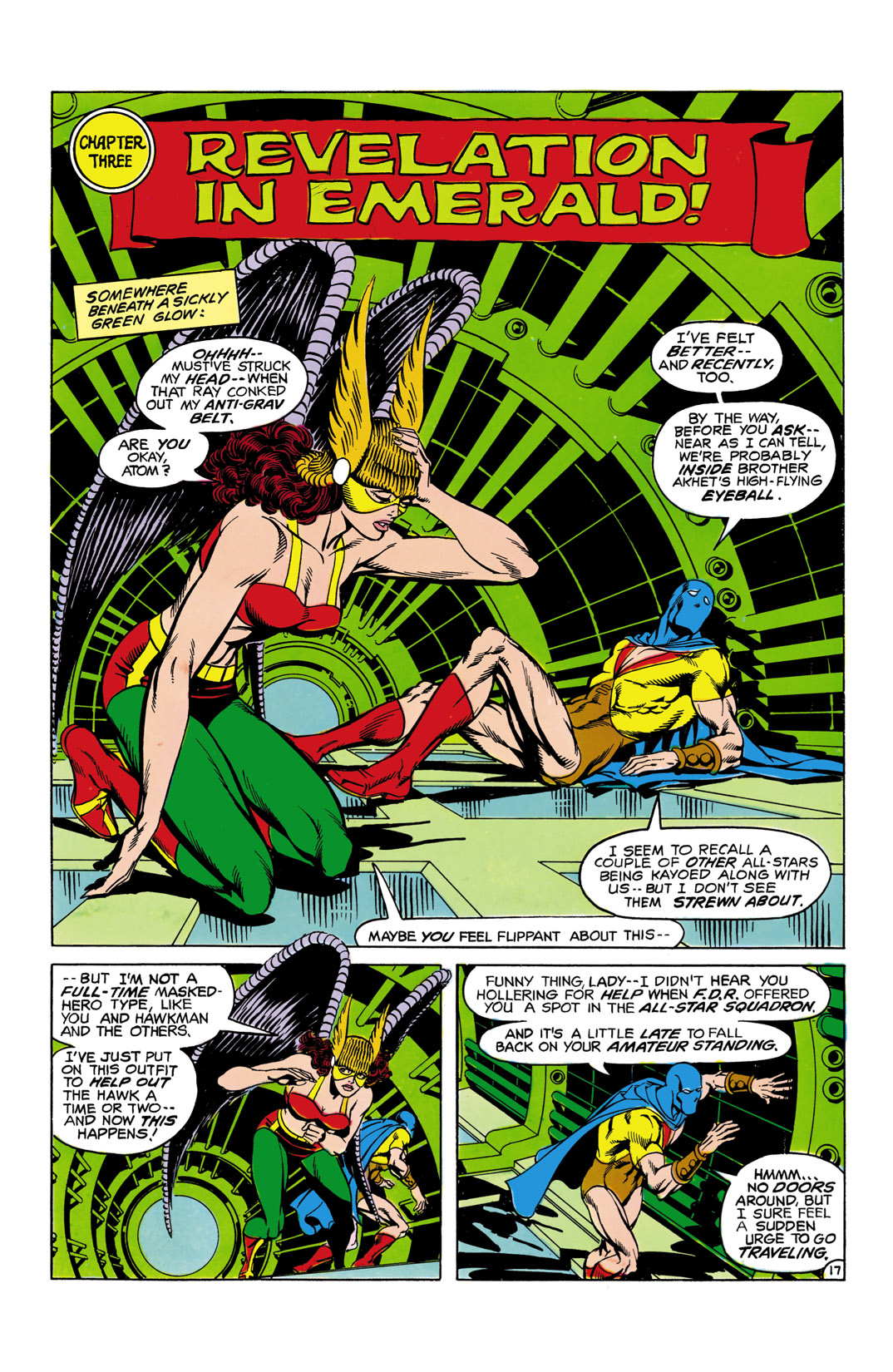
Hawkgirl and Atom go sightseeing and run into a door. Hawkgirl pulls out a dagger to pry it open, then relates how she picked her new headgear and the knife. Shwe looked over an array of helmets, and a cloth mask, and chose the one she has on, then picked up the dagger, from a box...
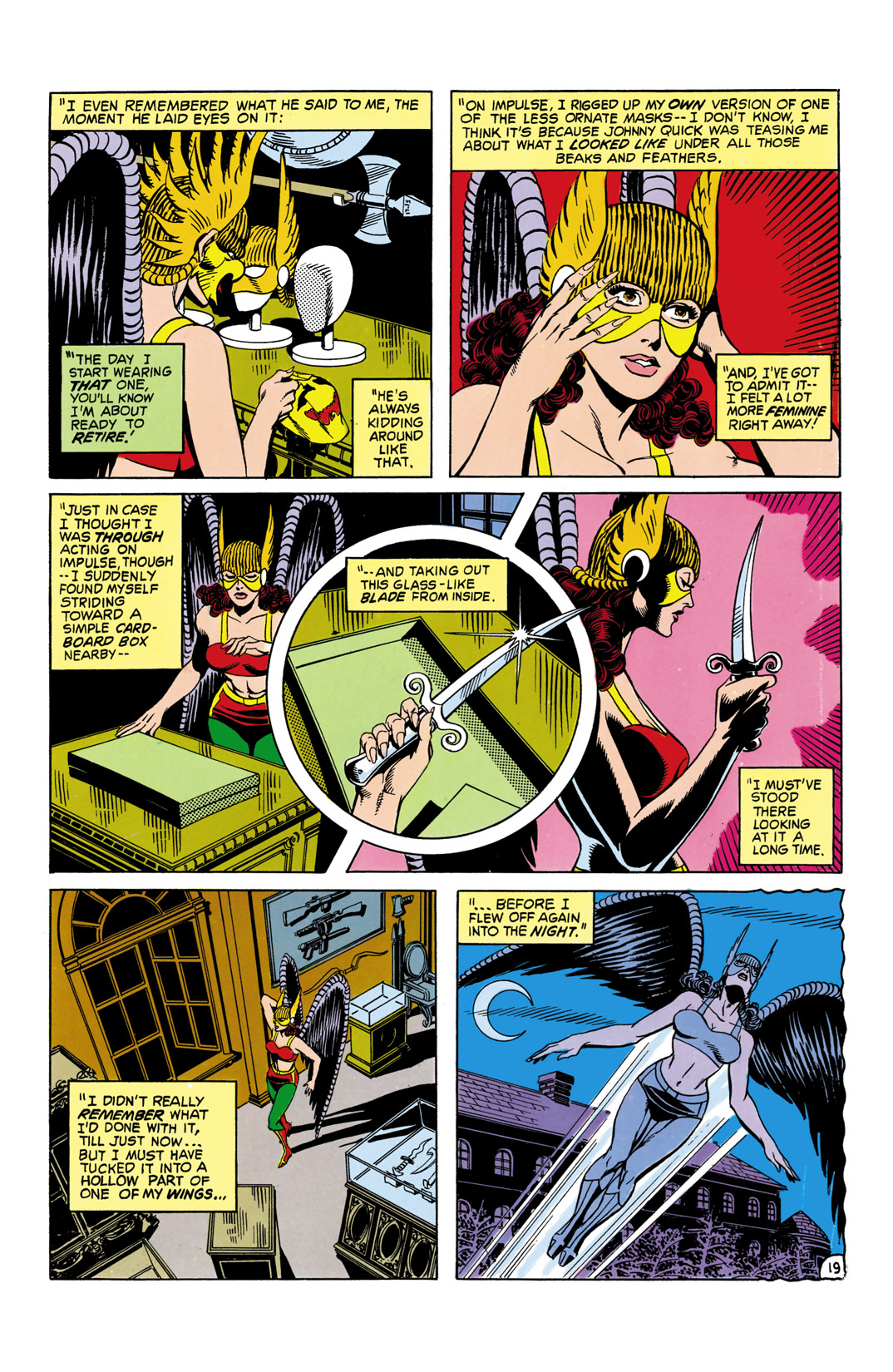
Meanwhile, Hawkman has the All-Stars investigating the Owens connection and they check for missing scientists and learn that one entire group, who ran out of funding all disappeared. Thw go to Elwood Napier's house (he's the last to disappear) and find a photo of the group, with someone in the background who looks familiar to Hawkman.
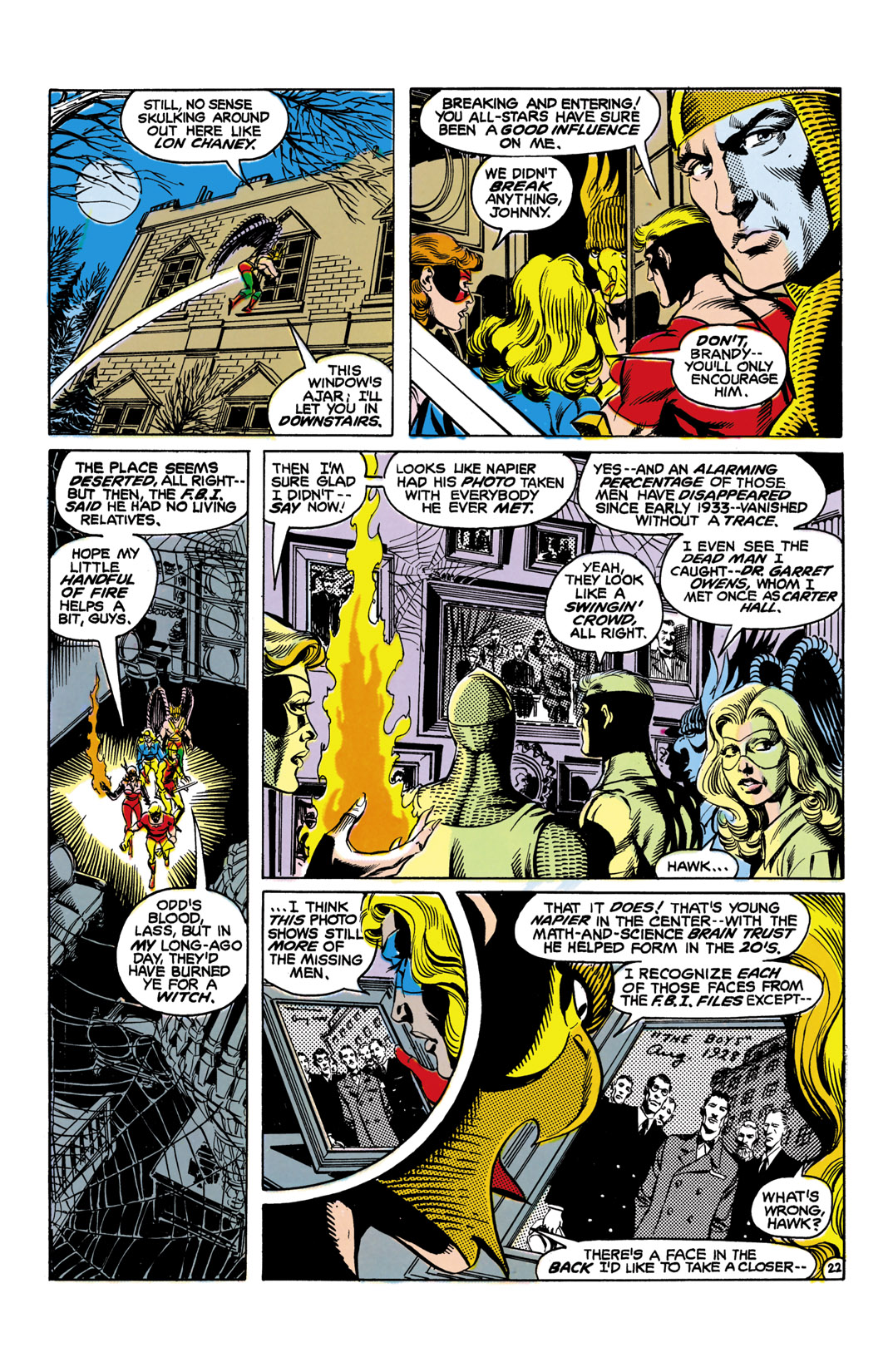
The pictures go up in flame, trigger by some alarm. On the eye, Atom and HG run into the alien and deck him, finding out he is a fake. They then find a chamber with all of the other All-Stars and the missing scientists.
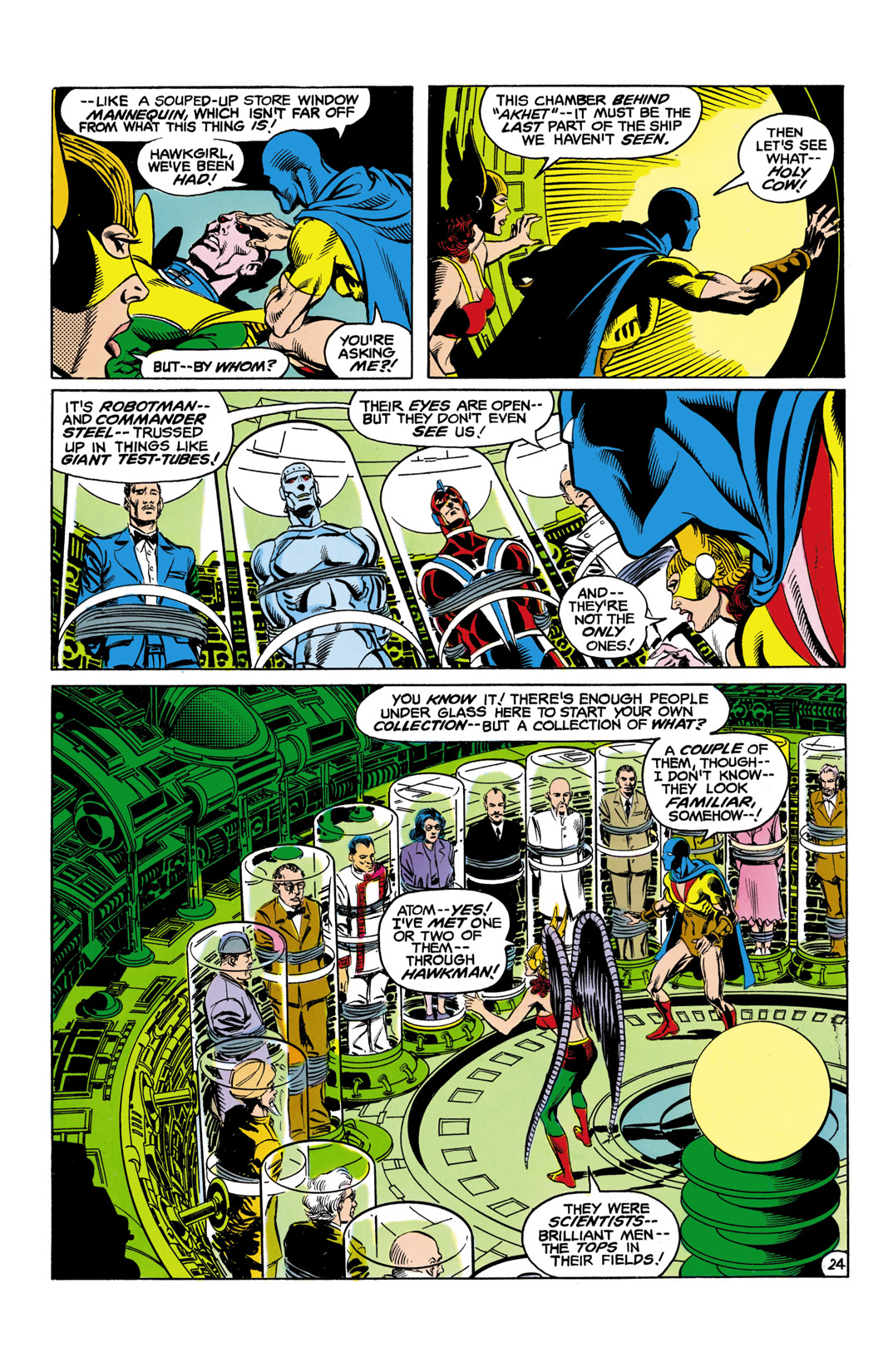
Can Kang and Kodos be far behind? Well, no; but, would you believe...
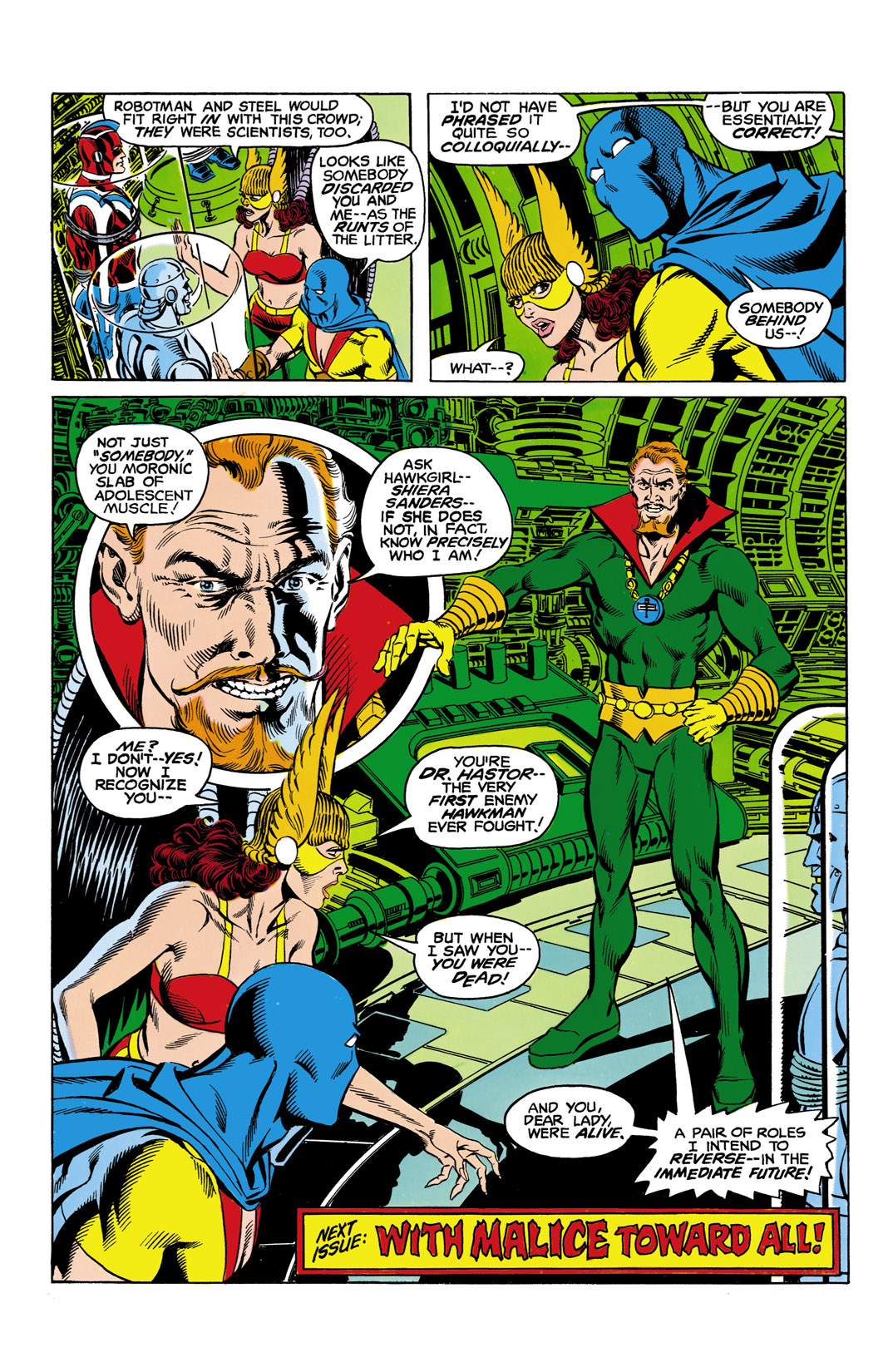
Dr. Hastor?
Thoughts: So, the alien is a fake. It's all a hoax! Why does that sound familiar? We'll get to that next time, as the full scope of the plot is revealed. So, Liberty Belle is the only All-Star with half a brain, who thinks through a problem, rather than punching it. Hawkman, too, to a certain extent.
Meanwhile, Roy gives us a reason why Hawkgirl changed her helmet, aside from the fact she looked goofy. We get a look at the various styles used over the years, including the cloth mask he wore at the end of the Golden Age and when the team was revived, in the Silver Age.
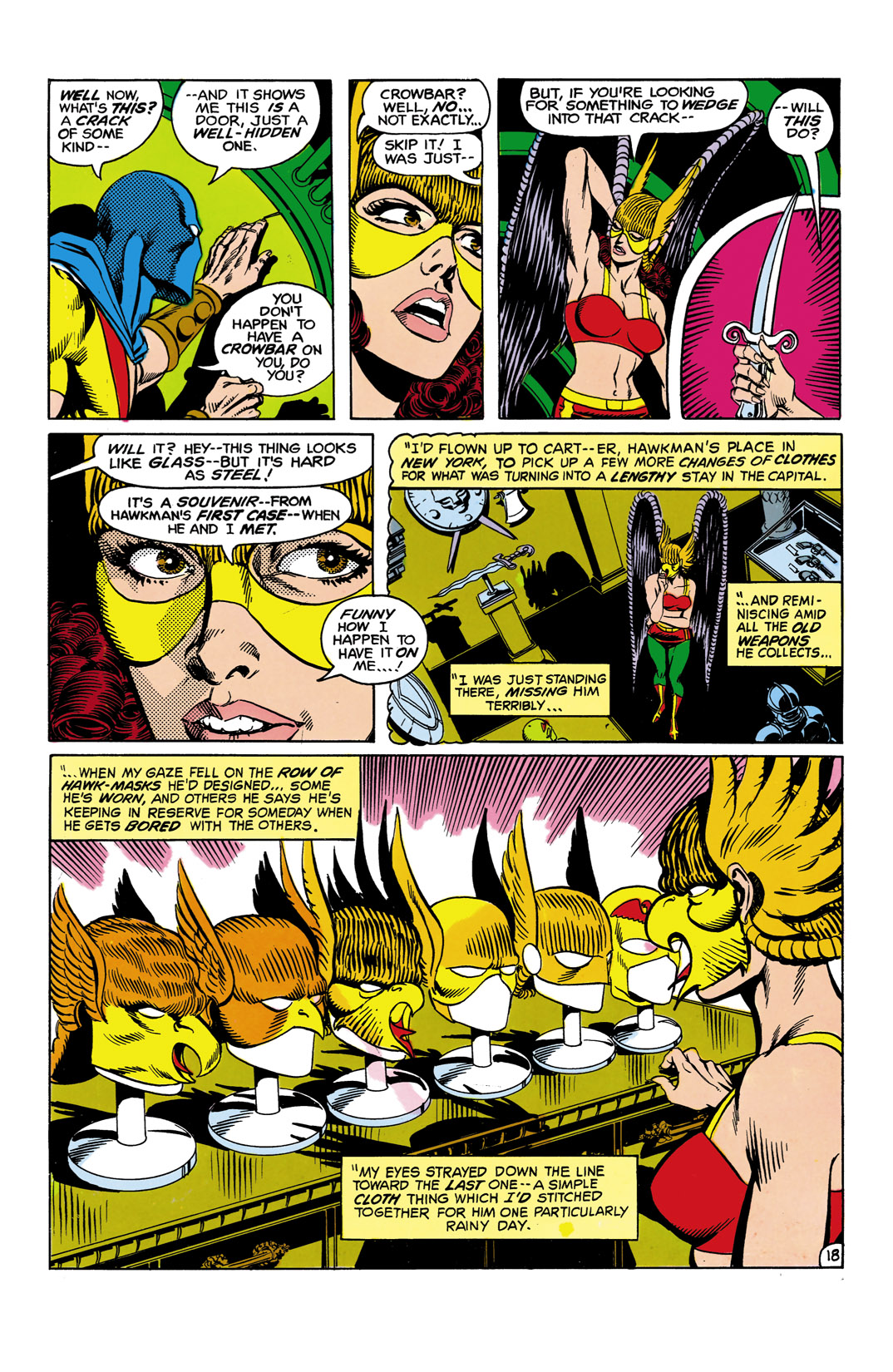
Johnny Quick mentions that we don't have operational jet aircraft. Jet engines were known technology, and the theory had been around a while; but, development wasn't overnight. However, the average American was oblivious to such things, unless they read a lot of science publications. Roy's being cute; but, Johnny is a newsreel cameraman; so, maybe he shot some footage of jet experiments. makes more sense than Sir Justin bringing it up.
Roy namechecks our allies and enemies, with the world leaders, just so everyone knows the players. He skips the neutral countries, though, which should have been used as a clue, if you ask me; but, we don't have that many pages and we hadn't gotten around to the dead guy.
Dr Hastor was the first villain faced by Hawkman, in Flash Comics #1. Roy will cover all of that next issue, and build upon it.
Historical Notes: not much to cover, really.
Wolf's Lair (Wolfsschanze, in German), Hitler's Eastern headquarters, was in what had been known as East Prussia, which is part of modern Poland. The complex was built after the Nazi occupation of Poland, in advance of Operation barbarossa, the invasion of the Soviet Union. it was guarded by the SS, who provided Hitler's personal bodyguard, yet it was also the site of Oberst Claus von Stauffenberg's attempt to assassinate Hitler, with a bomb, hidden inside his briefcase. The bomb exploded, wounding, but not killing Hitler.
The complex was 2.5 square miles in size, encompassing 3 security zones, built in a heavily forested area. The central zone featured the bunkers used by Hitler and his staff, with 2 meter thick reinforced concrete walls. It was ringed by steel and wire fencing and armed guards, made up of the elite bodyguard corps of the SS. Outside that was a secondary zone, with quarters for staff and officials, plus the military barracks. The final, outer zone consisted of watchtowers, checkpoints, and extensive fields of land mines. Buildings were camouflaged, to hide them from the air, as well as the bunker complexes built underground. The complex was used to administer the war on the Eastern front, until late 1944, when the Soviets launched the Baltic offensive. in November, in advance of the rapidly moving Red Army, the order was given to destroy the complex and over 18,000 pounds of TNT was used to destroy the complex; but, it didn't do the job. the Red Army captured the area, with much of it having withstood the explosions, due to the strength of construction. it took until 1955 to fully clear away the over 50,000 land mines.
The complex was built by the Todt Organization, which used slave labor to construct roads and buildings for the Nazis. It was begun under Fritz Todt, who was an engineer, who had overseen the construction of the Autobahn system, in germany, which was designed to allow rapid deployment of troops across Germany, to the West, which would later inspire the US Interstate System. Todt became reichsminister of Armaments and Ammunition, and his group began using forced labor to build roadways, military complexes, governments buildings and other projects, while also overseeing the manufacture of munitions for the nazi war machine. Todt was killed in a plane crash in 1942 and succeeded by Albert Speer.
Labor was provided by a mixture of prisoners from concentration camps, conscripted labor from occupied countries (referred to as "foreign laborers") and POWs.

Hitler's bunker.
Adolf Hitler came to power, in Germany, in 1933, when President Paul Von Hindenburg named him Reichschancellor, in hopes of quieting the Nazis. Hitler was born in Austria and served in the Wehrmacht, after enlisting in the Bavarian Army. By rights, he should have been returned to the Austro-Hungarian Army for service; but, it is believed that an administrative error allowed him to remain. he was a dispatch runner, carrying messages from Regimental headquarters to various outposts on the Western front, which gave him much time at the HQ. He was awarded the Iron Cross, 2nd Class for bravery, then th iron Cross, 1st class, as well as an award for being wounded. His desire was to be an artist, but proved a failure at it. he soon fell in with other former veterans, also failures at life. They soon looked for scapegoats for the defeat of Germany in the war and for the economic turmoil of Weimar Germany. the group became the Nationalsozialistische Deutsche Arbeiterpartei (National Socialist German Worker's Party), or the Nazi Party, for short. They became notorious for their thuggery and streetfighting against other political groups, especially the communists. An attempted coup in Bavaria, the Beer Hall Putsch, landed Hitler in jail, where he wrote his memoir, mein Kampf (My struggle) which laid blame on Jews and other elements of society and his plans for the future. Upon leaving jail he was even more popular and the Nazis increased in power. Hitler was a fiery orator, using populist messages that fed on fear and hatred, laying blame on outsiders and "non-Aryans" for Germany's defeat and economic turmoil, while speaking of rebuilding the greatness of Germany and their destiny. Behind the scenes, his private armies, the SA and SS intimidated and attacked other groups, smashed Jewish shops, beat and bullied people and committed outright murder. The Nazis, meanwhile, appealed to farmers and the middle class, providing programs aimed at aiding German workers and farmers, while the government proved unable to reverse the rampant inflation and job loss. The Nazis gained 107 seats in the Reichstag, as a result of the 1930 election. Hitler was appointed chancellor in 1933, with the backing of prominent industrial leaders and in Hindenburg's hopes it would quell Nazi dissent. Instead, it set Germany on the path to dictatorship. The SDP, the architects of the Weimar Constitution, were outlawed. Unions were smashed through violence, by the SA. The Reichstag Fire led to a propaganda campaign, blaming the communists and led to a suspension of basic rights and incarceration, without trial. Hindenburg died in 1934 and Hitler became sole power, as the office of president was abolished and all powers transferred to the chancellor. Hitler then used blackmail to clean out senior military ranks to bring the wehrmacht under his control, via the Blomberg-Fritsch Affair.
Benito Mussolini came to power in Italy, 1922, as head of the National Fascists Party. he had fled Italy to avoid military service, living in switzerland, where he became politically involved in the Italian community. A call for violent general strikes got him deported, though he turned around and went back, only returning to Italy after an amnesty for deserters was declared, in 1904. Part of the amnesty included military service, for 2 years and he served in the Bersaglieri. Afterward, he became a journalist and was involved in the Italian Socialist Party, until his expulsion, in 1914, for his support of intervention on the side of the Allies. he embraced nationalist groups. he also served in the trenches, until wounded in 1917. He continued his right wing politics after the war, forming the National fascist Party, which crossed class lines, while promoting racist ideologies. the Fascists led a march on Rome, in 1922, demanding the resignation of Prime Minister Luigi Facta, a liberal, and the election of a Fascist government. When King Victor Emmanuel III refused to declare martial law to disperse the Black Shirts, Facta resigned and the king turned power over to Mussolini. he consolidated power in Italy and engineered laws which outlawed other parties, after elections. He rescinded reforms in the colonies in Libya, returning to the policy of confiscating land for Italian colonists, leading to outright revolt. he then used the army to "pacify" Libya, in 1923, a war that lasted until 1932.
Mussolini promoted himself through propaganda that emphasized his skills as sportsman and musician, as well as personal control of interior ministries. He built a cult of personality around himself. he was a quick ally of the Nazi government and strong confidant of Hitler, though the definite junior partner in the war effort, especially after the Allied landings in Sicily and int he conduct of the war in North Africa. he was dismissed by the king and arrested. Hitler ordered his rescue and SS troops, under command of Otto Skorsene carried off a daring rescue from a mountain chalet in Gran sasso, landing in gliders and spiriting Mussolini off to Germany. He returned to northern italy, leader of a new republic, most of which was under German military control. With the Allies advancing on his territory, Mussolini and his mistress tried to escape to Spain, but were captured by Italian communist partisans and executed. there bodies were hung from a lamppost, where they were pelted with rocks.
Josef Stalin rose through the ranks of the Communist Party and was exiled to Siberia. He returned and was involved in organizing uprisings, at the dawn of the Russian Revolution. He rose in power through lenin's government and succeeded him as general Secretary, after his death. Stalin became supreme power in the Soviet Union and stamped out all opposition. His purges devastated Soviet society, targeting politcal dissent and creating a campaign of terror to instill discipline, with Jews heavily targeted. In 1939, he signed a pact with Germany, ensuring Soviet neutrality, while splitting Eastern Europe. The Soviets occupied eastern provinces of Poland and traded territory with the Nazis. Hitler concentrated on the West, while the Soviets dealt with japanese military buildups on their eastern borders. In 1941, after the defeat of France, Hitler launched Operation Barbarossa, the invasion of Russia, with hopes of gaining the fertile Russian and Ukranian farmland. The Russians proved stubborn fighters and the German advance was eventually halted and slowly reversed. The Russians entered into a pact with Britain and the US, with the US providing Lend Lease aid, in armaments and food, to aid their war effort. Eventually, the Red Army pushed the Germans back to their own borders and would finally capture the city of berlin, leading to hitler's suicide. Stalin continued to rule in the USSR until 1953, when he died of a brain hemorrhage, though there is some belief that he was murdered. Reforms were instituted after his death, returning collective power to the Party and was succeeded by Nikita Khrushchev.
Hideki Tojo was an Imperial Army general and part of the militarist group that sought to expand Japan's power and territory through conquest in Asia. they fought a rival faction, which sought to launch a coup to restore Imperial rule, which angered Hirohito and kled to his full support for the militarists. tojo was appointed Army Minister in 1940 and rose to full power, as Prime Minister, in 1941. Japan had already been fighting Chinese forces for control of the Manchurian region, with formal war beginning in 1937 (though the military occupation began in 1931). Tojo approved Army operational plans to launch simultaneous attacks in the Dutch and British East Indies, the Philippines, and a Naval plan to cripple the US fleet, at Pearl Harbor. That plans architect, Adm isoroku Yamamoto, had opposed the idea of attacking the US, having served as a naval attache to the US and having seen firsthand its industrial might. However, he dutifully drew up the attack plan, which was carried out, leading the US into the war. Tojo remained in power until the Japanese surrender, following the Atomic Bomb attacks on Hiroshima and Nagasaki, when Emp. Hirohito was persuaded to unconditionally surrender. Tojo was arrested and tried for War crimes. he attempted to shoot himself in the chest when troops came to arrest him, but survived. he was targeted for all blame for the war, in a political effort to shield the emperor and accepted the responsibility. he was executed by hanging on Dec. 23, 1948.
Generalissimo Chiang Kai-Shek had been a lieutenant in Sun Yat-sen's rebellion, with established the Republic of China. he rose to power in 1928, but soon found himself fighting a civil war against the Communists, under Mao, and the Japanese invasion of Manchuria. The nationalists controlled urban areas, but the Communist held much sway in rural areas, which constituted much of China. Kai-shek sought to modernize China and temper foreign influence through diplomacy, which angered many who supported Mao. His government proved ineffective in halting the Japanese or the Communists and was greatly propped up by the Allies during the war, while the Communists proved to have the tougher fighting forces. Eventually, after the war, the Communists and nationalists returned to fighting one another and Kai-Shek was forced to flee China to Taiwan, establishing the Nationalist republic there, which remains, though its political might has been massively reduced by the People's Republic of China, since the 1970s, particularly since China became the center of much of the world's manufacturing. Kai-shek died in 1975.
Next time, we will explore the idea of a hoax creating an emergency in the US (of a sort).